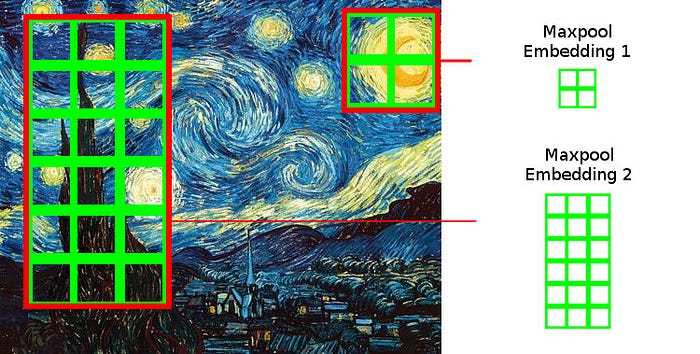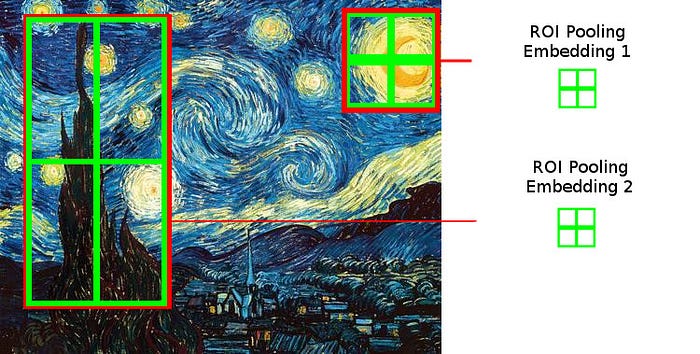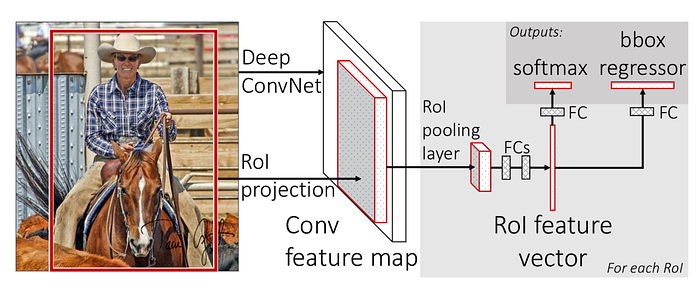Hello, Habr! I present to your attention the translation of the article "Implementing RoI Pooling in TensorFlow + Keras" by Jaime Sevilla.
I am currently taking a machine learning course. In the training block "Computer vision" there was a need to study RoI Pooling of layers. The article below seemed interesting to me, and therefore I decided to share the translation with the community.
In this post, we will explain the basic concept and general usage of RoI pooling ( Region of Interest ) and provide an implementation using TensorFlow Keras layers.
The target audience of this post is people who are familiar with basic theory of (Convolutional) Neural Networks (CNNs) and are able to build and run simple models using Keras .
If you're only here for code, check here and don't forget to like and share the article!
Understanding RoI Pooling
RoI Pooling was proposed by Ross Girshik in Fast R-CNN article as part of his object recognition pipeline.
In a general use case for RoI Pooling , we have an image-like object and several regions of interest ( RoIs ) specified through bounding boxes. We want to create embeddings (embeddings - mapping an arbitrary entity (a piece of a picture) to a certain vector) from each RoI.
For example, in an R-CNN setup, we have an image and a candidate region highlighting engine that creates bounding boxes for potentially interesting parts of the image. Now we want to create an embedding for each suggested piece of the image.

Simply cropping each suggested area will not work because we want to superimpose the resulting embeddings on top of each other, and the suggested areas do not necessarily have the same shape!
, . ?
- (pooling).
max pooling, ( ) , , .

maxpool
, – : .
. RoI ?

ROI Pooling , pooling.
, ROI Pooling.
RoI Pooling.
RoI Pooling — . , RoI, . , .
-, ( RoI Pooling ), ( ), (end-to-end) (single-pass) .

Fast R-CNN, RoI Pooling,
, R-CNN , (RoI). RoI Pooling CNN . .
-, -, RoI Pooling (visual attention).

Attentional Network , ROI Pooling, Hara ..
Attentional Network , Hara attention, ROI ROI Pooling. (t = 1), ROI Pooling (Fully Connected). Glimpse () (t = 2) , ROI Pooling. .
.
, , ROI.
:
- (batch) . , . (batch_size, img_width, img_height, n_channels), batch_size- , img_width — , img_height — , n_channels — .
- (batch) ROI. , - . 4 , (batch_size, n_rois, 4), batch_size — ROI, n_rois — ROI.
:
- , ROI. (batch_size, n_rois, pooled_width, pooled_height, n_channels). batch_size- , n_rois — ROI, pooled_width — , pooled_height— , n_channels — .
Keras
Keras Layer.
tf.keras init, build call . , build , , . compute_output_shape.
, .
def __init__(self, pooled_height, pooled_width, **kwargs):
self.pooled_height = pooled_height
self.pooled_width = pooled_width
super(ROIPoolingLayer, self).__init__(**kwargs). , . .
def compute_output_shape(self, input_shape):
""" Returns the shape of the ROI Layer output
"""
feature_map_shape, rois_shape = input_shape
assert feature_map_shape[0] == rois_shape[0]
batch_size = feature_map_shape[0]
n_rois = rois_shape[1]
n_channels = feature_map_shape[3]
return (batch_size, n_rois, self.pooled_height,
self.pooled_width, n_channels)compute_output_shape — , , .
(call). — , . , ROI Pooling, .
, , ROI .
.
@staticmethod
def _pool_roi(feature_map, roi, pooled_height, pooled_width):
""" Applies ROI Pooling to a single image and a single ROI
"""# Compute the region of interest
feature_map_height = int(feature_map.shape[0])
feature_map_width = int(feature_map.shape[1])
h_start = tf.cast(feature_map_height * roi[0], 'int32')
w_start = tf.cast(feature_map_width * roi[1], 'int32')
h_end = tf.cast(feature_map_height * roi[2], 'int32')
w_end = tf.cast(feature_map_width * roi[3], 'int32')
region = feature_map[h_start:h_end, w_start:w_end, :]
..., .
, ROI , 0 1. , ROI 4- , (x_min, y_min, x_max, y_max ).
ROI , , , : , , ROI Pooling, , , ROI.
, TensorFlow.
...
# Divide the region into non overlapping areas
region_height = h_end - h_start
region_width = w_end - w_start
h_step = tf.cast(region_height / pooled_height, 'int32')
w_step = tf.cast(region_width / pooled_width , 'int32')
areas = [[(
i*h_step,
j*w_step,
(i+1)*h_step if i+1 < pooled_height else region_height,
(j+1)*w_step if j+1 < pooled_width else region_width
)
for j in range(pooled_width)]
for i in range(pooled_height)]
...ROI, .
2D , , , .
, , , , ROI (region_height // pooled_height, region_width // pooled_width), ROI, .
2D , .
...
# Take the maximum of each area and stack the result
def pool_area(x):
return tf.math.reduce_max(region[x[0]:x[2],x[1]:x[3],:], axis=[0,1])
pooled_features = tf.stack([[pool_area(x) for x in row] for row in areas])
return pooled_features . pool_area, , , , , .
pool_area , , list comprehension .
(pooled_height, pooled_width, n_channels), RoI .
— RoI . tf.map_fn (n_rois, pooled_height, pooled_width, n_channels).
@staticmethod
def _pool_rois(feature_map, rois, pooled_height, pooled_width):
""" Applies ROI pooling for a single image and varios ROIs
"""
def curried_pool_roi(roi):
return ROIPoolingLayer._pool_roi(feature_map, roi,
pooled_height, pooled_width)
pooled_areas = tf.map_fn(curried_pool_roi, rois, dtype=tf.float32)
return pooled_areas, . tf.map_fn (, x), , .
def call(self, x):
""" Maps the input tensor of the ROI layer to its output
"""
def curried_pool_rois(x):
return ROIPoolingLayer._pool_rois(x[0], x[1],
self.pooled_height,
self.pooled_width)
pooled_areas = tf.map_fn(curried_pool_rois, x, dtype=tf.float32)
return pooled_areas, dtype tf.map_fn , . , , , Tensorflow.
:
import tensorflow as tf
from tensorflow.keras.layers import Layer
class ROIPoolingLayer(Layer):
""" Implements Region Of Interest Max Pooling
for channel-first images and relative bounding box coordinates
# Constructor parameters
pooled_height, pooled_width (int) --
specify height and width of layer outputs
Shape of inputs
[(batch_size, pooled_height, pooled_width, n_channels),
(batch_size, num_rois, 4)]
Shape of output
(batch_size, num_rois, pooled_height, pooled_width, n_channels)
"""
def __init__(self, pooled_height, pooled_width, **kwargs):
self.pooled_height = pooled_height
self.pooled_width = pooled_width
super(ROIPoolingLayer, self).__init__(**kwargs)
def compute_output_shape(self, input_shape):
""" Returns the shape of the ROI Layer output
"""
feature_map_shape, rois_shape = input_shape
assert feature_map_shape[0] == rois_shape[0]
batch_size = feature_map_shape[0]
n_rois = rois_shape[1]
n_channels = feature_map_shape[3]
return (batch_size, n_rois, self.pooled_height,
self.pooled_width, n_channels)
def call(self, x):
""" Maps the input tensor of the ROI layer to its output
# Parameters
x[0] -- Convolutional feature map tensor,
shape (batch_size, pooled_height, pooled_width, n_channels)
x[1] -- Tensor of region of interests from candidate bounding boxes,
shape (batch_size, num_rois, 4)
Each region of interest is defined by four relative
coordinates (x_min, y_min, x_max, y_max) between 0 and 1
# Output
pooled_areas -- Tensor with the pooled region of interest, shape
(batch_size, num_rois, pooled_height, pooled_width, n_channels)
"""
def curried_pool_rois(x):
return ROIPoolingLayer._pool_rois(x[0], x[1],
self.pooled_height,
self.pooled_width)
pooled_areas = tf.map_fn(curried_pool_rois, x, dtype=tf.float32)
return pooled_areas
@staticmethod
def _pool_rois(feature_map, rois, pooled_height, pooled_width):
""" Applies ROI pooling for a single image and varios ROIs
"""
def curried_pool_roi(roi):
return ROIPoolingLayer._pool_roi(feature_map, roi,
pooled_height, pooled_width)
pooled_areas = tf.map_fn(curried_pool_roi, rois, dtype=tf.float32)
return pooled_areas
@staticmethod
def _pool_roi(feature_map, roi, pooled_height, pooled_width):
""" Applies ROI pooling to a single image and a single region of interest
"""
# Compute the region of interest
feature_map_height = int(feature_map.shape[0])
feature_map_width = int(feature_map.shape[1])
h_start = tf.cast(feature_map_height * roi[0], 'int32')
w_start = tf.cast(feature_map_width * roi[1], 'int32')
h_end = tf.cast(feature_map_height * roi[2], 'int32')
w_end = tf.cast(feature_map_width * roi[3], 'int32')
region = feature_map[h_start:h_end, w_start:w_end, :]
# Divide the region into non overlapping areas
region_height = h_end - h_start
region_width = w_end - w_start
h_step = tf.cast( region_height / pooled_height, 'int32')
w_step = tf.cast( region_width / pooled_width , 'int32')
areas = [[(
i*h_step,
j*w_step,
(i+1)*h_step if i+1 < pooled_height else region_height,
(j+1)*w_step if j+1 < pooled_width else region_width
)
for j in range(pooled_width)]
for i in range(pooled_height)]
# take the maximum of each area and stack the result
def pool_area(x):
return tf.math.reduce_max(region[x[0]:x[2], x[1]:x[3], :], axis=[0,1])
pooled_features = tf.stack([[pool_area(x) for x in row] for row in areas])
return pooled_features! , 1- 100x200, 2 RoI, 7x3. , 4 . — 1, 50 (-1, -3).
import numpy as np# Define parameters
batch_size = 1
img_height = 200
img_width = 100
n_channels = 1
n_rois = 2
pooled_height = 3
pooled_width = 7# Create feature map input
feature_maps_shape = (batch_size, img_height, img_width, n_channels)
feature_maps_tf = tf.placeholder(tf.float32, shape=feature_maps_shape)
feature_maps_np = np.ones(feature_maps_tf.shape, dtype='float32')
feature_maps_np[0, img_height-1, img_width-3, 0] = 50
print(f"feature_maps_np.shape = {feature_maps_np.shape}")# Create batch size
roiss_tf = tf.placeholder(tf.float32, shape=(batch_size, n_rois, 4))
roiss_np = np.asarray([[[0.5,0.2,0.7,0.4], [0.0,0.0,1.0,1.0]]], dtype='float32')
print(f"roiss_np.shape = {roiss_np.shape}")# Create layer
roi_layer = ROIPoolingLayer(pooled_height, pooled_width)
pooled_features = roi_layer([feature_maps_tf, roiss_tf])
print(f"output shape of layer call = {pooled_features.shape}")# Run tensorflow session
with tf.Session() as session:
result = session.run(pooled_features,
feed_dict={feature_maps_tf:feature_maps_np,
roiss_tf:roiss_np})
print(f"result.shape = {result.shape}")
print(f"first roi embedding=\n{result[0,0,:,:,0]}")
print(f"second roi embedding=\n{result[0,1,:,:,0]}"), TensorFlow, .
:
feature_maps_np.shape = (1, 200, 100, 1)
roiss_np.shape = (1, 2, 4)
output shape of layer call = (1, 2, 3, 7, 1)
result.shape = (1, 2, 3, 7, 1)
first roi embedding=
[[1. 1. 1. 1. 1. 1. 1.]
[1. 1. 1. 1. 1. 1. 1.]
[1. 1. 1. 1. 1. 1. 1.]]
second roi embedding=
[[ 1. 1. 1. 1. 1. 1. 1.]
[ 1. 1. 1. 1. 1. 1. 1.]
[ 1. 1. 1. 1. 1. 1. 50.]], . — 1, , 50.
, !
, !
, ROI Pooling (attention). , , Keras , ROI Pooling .
, , , !
Ari Brill, Tjark Miener Bryan Kim .
- Ross Girshick. Fast R-CNN. Proceedings of the IEEE International Conference on Computer Vision. 2015.
- Kota Hara, Ming-Yu Liu, Oncel Tuzel, Amir-massoud Farahmand. Attentional Network for Visual Object Detection. 2017.